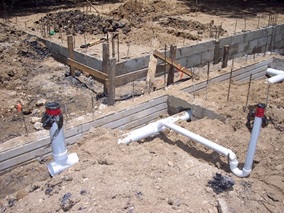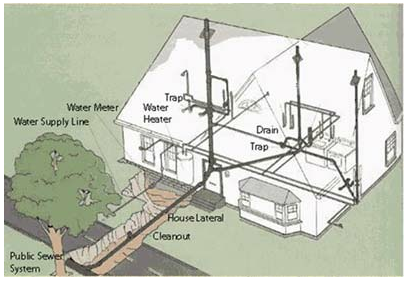A Comprehensive Guide to Your House's Plumbing System Anatomy
A Comprehensive Guide to Your House's Plumbing System Anatomy
Blog Article
Each person maintains their own individual assumption on the subject of Anatomy of a House: Understanding the Components.

Comprehending exactly how your home's pipes system functions is crucial for every house owner. From supplying clean water for drinking, food preparation, and bathing to safely getting rid of wastewater, a properly maintained plumbing system is critical for your family's health and wellness and convenience. In this comprehensive overview, we'll discover the detailed network that makes up your home's plumbing and deal pointers on upkeep, upgrades, and handling common problems.
Introduction
Your home's plumbing system is greater than simply a network of pipelines; it's a complicated system that guarantees you have accessibility to clean water and efficient wastewater removal. Understanding its elements and exactly how they collaborate can assist you avoid costly repair work and ensure everything runs efficiently.
Standard Elements of a Pipes System
Pipes and Tubes
At the heart of your pipes system are the pipelines and tubes that lug water throughout your home. These can be constructed from numerous products such as copper, PVC, or PEX, each with its benefits in terms of resilience and cost-effectiveness.
Fixtures: Sinks, Toilets, Showers, and so on.
Components like sinks, bathrooms, showers, and tubs are where water is utilized in your home. Understanding how these components attach to the pipes system aids in identifying problems and intending upgrades.
Shutoffs and Shut-off Factors
Valves control the circulation of water in your plumbing system. Shut-off valves are crucial throughout emergencies or when you require to make fixings, permitting you to separate parts of the system without disrupting water circulation to the entire house.
Water Supply System
Key Water Line
The major water line links your home to the municipal water supply or a private well. It's where water enters your home and is dispersed to different fixtures.
Water Meter and Pressure Regulator
The water meter procedures your water usage, while a stress regulator makes sure that water flows at a secure pressure throughout your home's plumbing system, stopping damages to pipes and fixtures.
Cold Water vs. Warm water Lines
Understanding the distinction in between cold water lines, which supply water directly from the major, and hot water lines, which lug warmed water from the water heater, assists in repairing and planning for upgrades.
Drain System
Drain Pipes Pipeline and Traps
Drain pipes bring wastewater away from sinks, showers, and commodes to the sewer or septic tank. Catches prevent drain gases from entering your home and likewise catch debris that might create clogs.
Air flow Pipelines
Air flow pipes enable air right into the drain system, protecting against suction that can slow drainage and create catches to empty. Proper ventilation is important for preserving the stability of your pipes system.
Importance of Proper Drain
Guaranteeing correct drain stops backups and water damage. On a regular basis cleaning up drains and keeping traps can protect against costly fixings and prolong the life of your pipes system.
Water Heating Unit
Sorts Of Water Heaters
Hot water heater can be tankless or conventional tank-style. Tankless heating systems warm water as needed, while storage tanks keep warmed water for instant usage.
Updating Your Plumbing System
Factors for Upgrading
Upgrading to water-efficient components or changing old pipes can enhance water high quality, lower water bills, and enhance the worth of your home.
Modern Pipes Technologies and Their Advantages
Discover technologies like clever leakage detectors, water-saving commodes, and energy-efficient hot water heater that can conserve cash and minimize environmental impact.
Cost Considerations and ROI
Determine the upfront costs versus lasting cost savings when thinking about plumbing upgrades. Numerous upgrades spend for themselves with reduced energy expenses and fewer repairs.
How Water Heaters Connect to the Pipes System
Comprehending how hot water heater attach to both the cold water supply and warm water distribution lines helps in diagnosing concerns like not enough hot water or leakages.
Maintenance Tips for Water Heaters
Routinely purging your water heater to remove debris, checking the temperature level settings, and checking for leaks can prolong its lifespan and boost power effectiveness.
Usual Pipes Concerns
Leakages and Their Causes
Leakages can take place because of aging pipes, loose installations, or high water pressure. Resolving leakages quickly prevents water damage and mold development.
Blockages and Blockages
Clogs in drains pipes and bathrooms are frequently triggered by flushing non-flushable items or a build-up of grease and hair. Utilizing drain displays and bearing in mind what decreases your drains can prevent obstructions.
Indicators of Plumbing Problems to Expect
Low tide stress, sluggish drains, foul odors, or unusually high water costs are signs of potential pipes troubles that ought to be dealt with promptly.
Plumbing Maintenance Tips
Regular Inspections and Checks
Arrange annual plumbing inspections to capture problems early. Try to find indications of leaks, corrosion, or mineral build-up in taps and showerheads.
DIY Maintenance Tasks
Simple jobs like cleaning faucet aerators, looking for commode leaks making use of color tablets, or insulating exposed pipes in cold climates can avoid significant plumbing problems.
When to Call an Expert Plumbing Technician
Know when a plumbing problem needs professional know-how. Attempting complex repairs without proper expertise can bring about more damages and greater fixing costs.
Tips for Reducing Water Usage
Easy practices like repairing leakages immediately, taking much shorter showers, and running complete lots of laundry and dishes can conserve water and lower your energy bills.
Eco-Friendly Pipes Options
Take into consideration lasting pipes products like bamboo for floor covering, which is durable and green, or recycled glass for kitchen counters.
Emergency situation Readiness
Steps to Take During a Pipes Emergency situation
Know where your shut-off shutoffs lie and how to switch off the supply of water in case of a burst pipe or major leak.
Importance of Having Emergency Situation Calls Convenient
Maintain get in touch with info for local plumbing professionals or emergency situation solutions easily available for quick feedback during a plumbing crisis.
Ecological Influence and Preservation
Water-Saving Fixtures and Appliances
Mounting low-flow taps, showerheads, and bathrooms can considerably lower water use without giving up efficiency.
DIY Emergency Fixes (When Suitable).
Short-term fixes like making use of duct tape to patch a leaking pipeline or positioning a pail under a trickling tap can lessen damage until a professional plumbing technician shows up.
Final thought.
Comprehending the makeup of your home's pipes system equips you to preserve it efficiently, conserving money and time on repair work. By following regular upkeep regimens and staying educated regarding modern pipes innovations, you can ensure your pipes system runs effectively for years ahead.
The Anatomy of Your Home s Plumbing System
Understanding the anatomy of your home s plumbing system is essential for any homeowner. It not only helps in identifying potential issues but also facilitates effective communication with professionals when repairs or upgrades are needed. Your home s plumbing system is more than just pipes and faucets; it s a complex network that ensures the efficient and hygienic flow of water in and out of your house. In this blog, we ll dissect the crucial components of your home s plumbing system. For those in Antelope Valley, Brock Plumbing is your trusted partner for all your plumbing needs, ensuring your system functions smoothly and efficiently.
Water Supply System
Main Water Line: This is where your home s plumbing system begins. The main water line connects your home to the public water supply or a private well. Pipes and Shut-off Valves: Pipes distribute water throughout your home. Shut-off valves are crucial for controlling the flow of water and making repairs without shutting off the entire system. Drainage System
Drain Pipes: These pipes carry waste and water away from sinks, toilets, and showers. Vents: Vents allow sewer gases to escape and help maintain proper pressure in the drainage pipes, ensuring efficient flow of wastewater. Traps: Every fixture has a trap, a U-shaped pipe that holds water and prevents sewer gases from entering your home. The most common is the P-trap under sinks. Fixtures and Appliances
Fixtures and appliances are the most interacted with parts of your plumbing system. They include sinks, toilets, showers, dishwashers, and washing machines. Each fixture and appliance has its own supply and drainage connection, ensuring they receive clean water and can dispose of wastewater effectively.
Water Heating System
Your water heater is a crucial component, providing hot water to various fixtures and appliances in your home. It can be tank-based or tankless, with each type having its own set of advantages and maintenance requirements. Regular maintenance is essential to ensure efficient operation and extend the lifespan of the unit.
Sump Pump
In areas prone to flooding or with high water tables, a sump pump is an essential part of the plumbing system. It s installed in the lowest part of your basement or crawlspace and pumps out water that accumulates, preventing flooding and protecting your home from water damage.
Septic System
Homes that are not connected to a municipal sewer system have a septic system and an underground wastewater treatment structure. Understanding how to maintain your septic system is crucial to prevent backups, odors, and early system failure.
Conclusion
Your home s plumbing system is a complex and essential network, ensuring the efficient and hygienic flow of water in and out of your property. Understanding its key components helps in maintaining it properly and identifying issues before they escalate into major problems. For residents in Antelope Valley, Brock Plumbing is dedicated to providing top-notch services, ensuring that every part of your plumbing system is in perfect working order. Trust our team of professionals to handle all your plumbing needs, ensuring your home remains comfortable, safe, and well-maintained.
https://brockplumbinganddrains.com/blog/the-anatomy-of-your-homes-plumbing-system/

Do you enjoy reading up on ? Give a review directly below. We'd be delighted to know your opinion about this write-up. We hope that you come back again later on. I beg you take the time to share this blog post if you liked it. We thank you for your readership.
Book Today Report this page